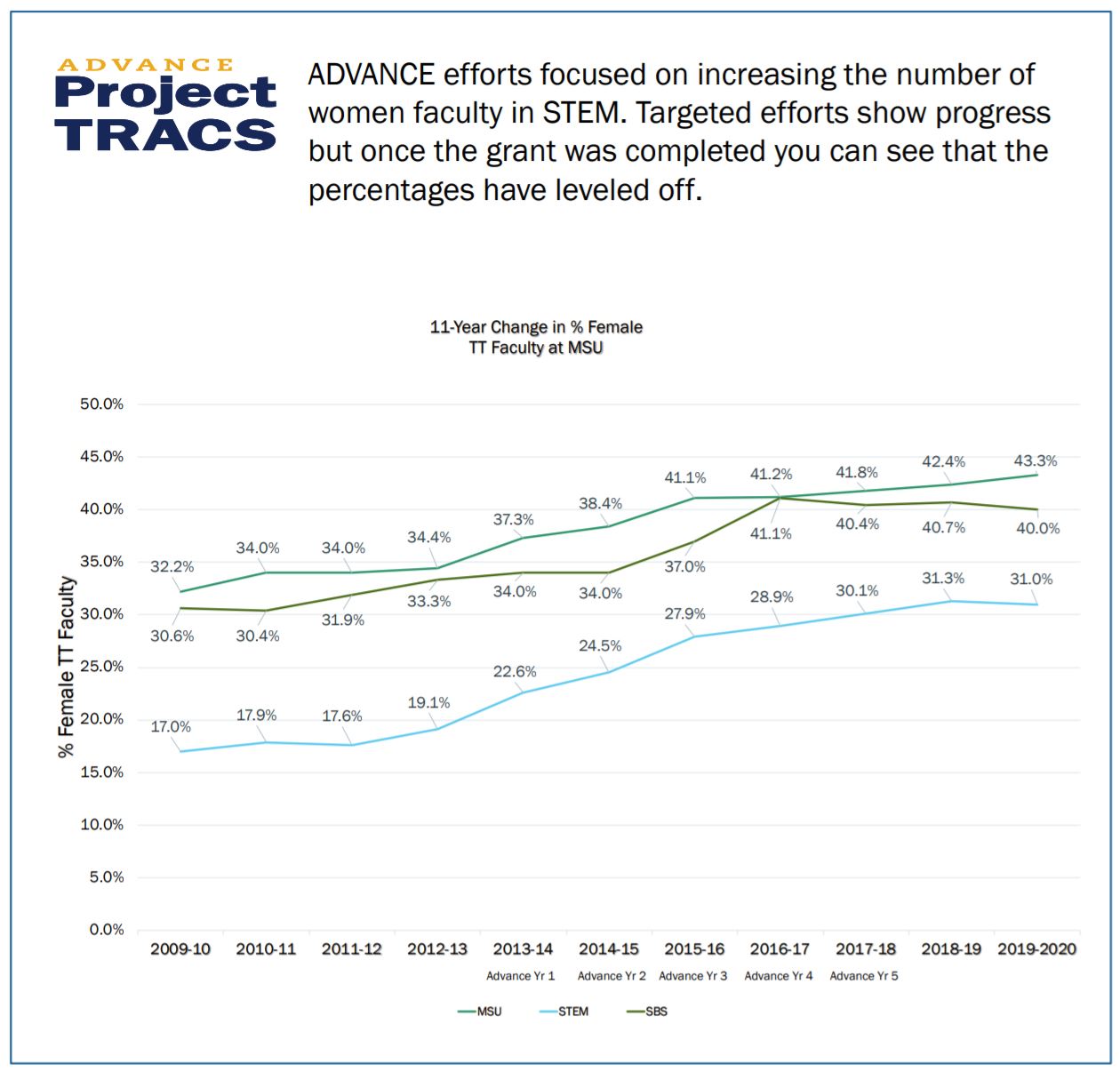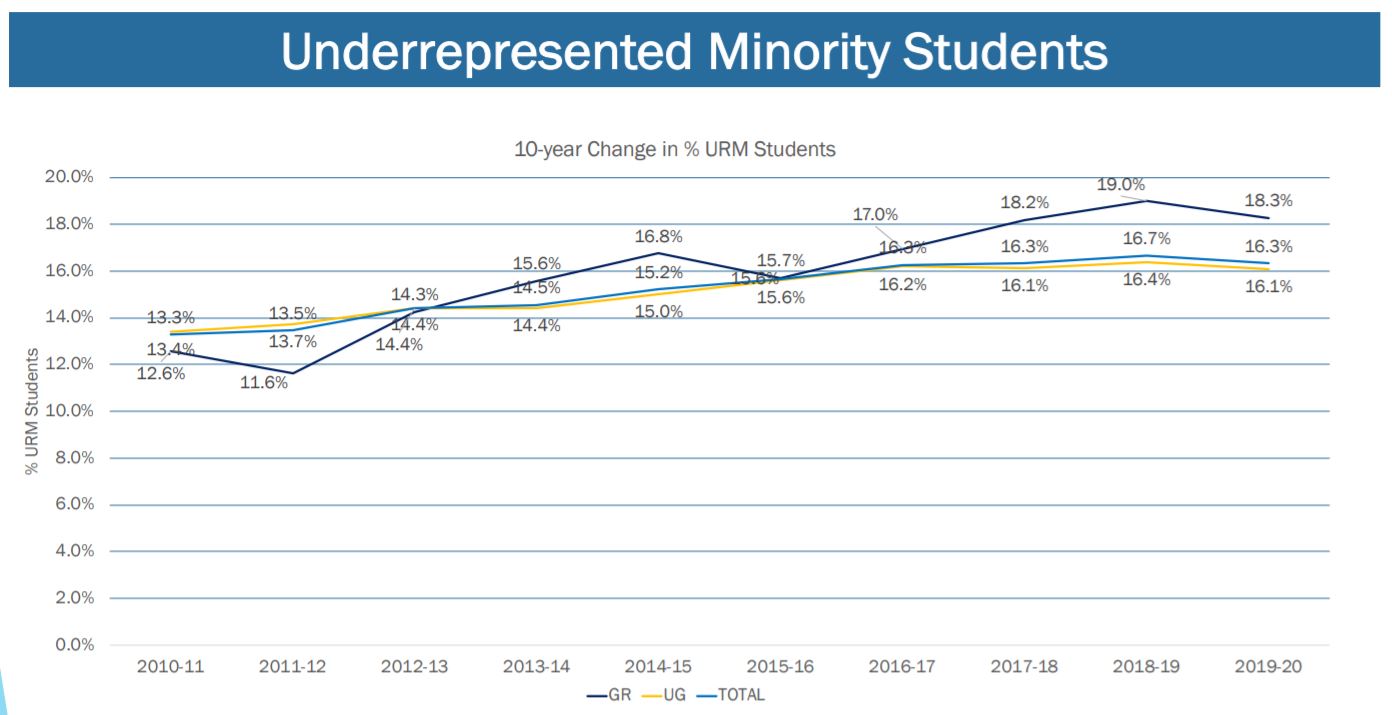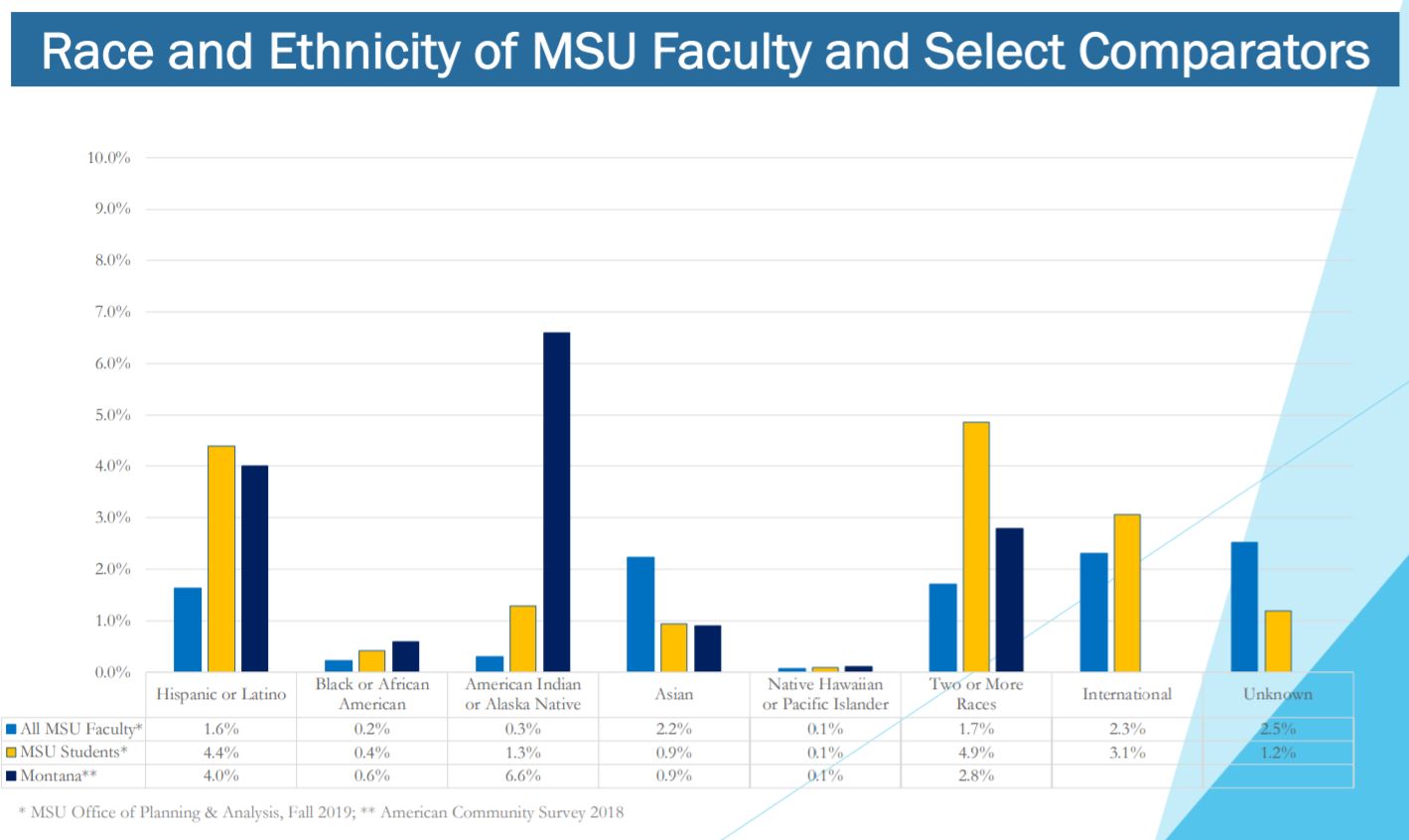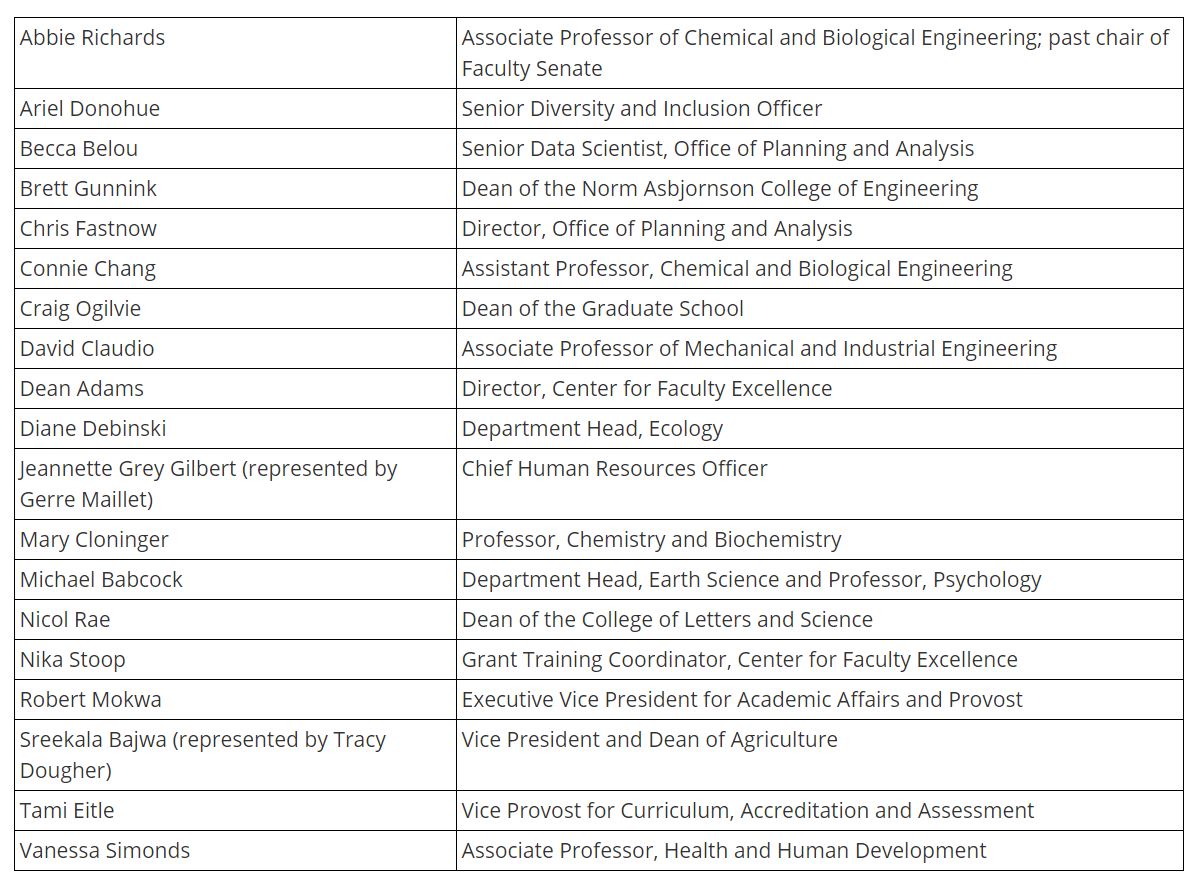IChange Open Forum
November 5 and 7, 2019
Montana State University is a member of the first cohort of the Aspire Alliance’s Institutional Change (IChange) network, a national effort to increase the diversity and inclusivity of STEM faculty. MSU’s IChange team consists of a diverse group of faculty members, staff, and academic leaders who have been carefully reflecting on MSU’s existing practices over the past few months. This year, the team will be seeking input and participation from all MSU stakeholders as they develop a customized, targeted plan to diversify MSU’s professoriate and ensure that teaching practices are inclusive.
Your participation in this planning process is critical to the success of these efforts. For those unable to attend an open forum, find a summary of the information presented below.
Why diversity is important
Diversity benefits society
Education within a diverse setting prepares students to become good citizens in an increasingly complex, pluralistic society; it fosters mutual respect and teamwork; and it helps build communities whose members are judged by the quality of their character and their contributions. ₁
Diversity benefits education
Rich educational experience: We learn from those whose experiences, beliefs, and perspectives are different from our own, and these lessons can be taught best in a richly diverse intellectual and social environment. Opportunities to interact with diverse faculty lead to greater active thinking, intellectual engagement and motivation.₁
Student engagement: We learn from those whose experiences, beliefs, and perspectives are different from our own, and these lessons can be taught best in a richly diverse intellectual and social environment. Opportunities to interact with diverse faculty lead to greater active thinking, intellectual engagement and motivation.₁
Student identity exploration: Students whose college experiences included diverse interactions report:
- Greater awareness of social problems
- Relating well to people of different races, nations and religions
- Increased independent skill and knowledge acquisition₃
Campus climate: Students who perceive their campus climate as inclusive and nondiscriminatory show greater willingness to accept intellectual challenges.₄
₁ On the Importance of Diversity in Higher Education. (2012). Retrieved from American
Council on Education website.
₂ Hagedorn, L. S., Chi, W. Y., Cepeda, R. M., & McLain, M. (2007). An investigation
of critical mass: The role of Latino representation in the success of urban community
college students. Research in Higher Education, 4, 73-91.
₃ Loo, J. & Jamieson-Drake, D. (2009). A retrospective assessment of the educational
benefits of interaction across racial boundaries. Journal of College Student Development.
50, 67-86.
₄ Pascarella, E.T., Edison, E.T., Edison, M., Nora, A., Hagedorn, L.S., & Terenzini,
P.T. (1996). Influences on students‘ openness to diversity and challenge in the first
year of college. Journal of Higher Education, 67, 174-195
Faculty diversity benefits all
Academic Engagement: Faculty of color employ a broader range of pedagogical techniques compared with their White counterparts, are more likely to promote interaction amongst diverse peers, engage students in research activities, and emphasize critical thinking.₅
College satisfaction: Students who have the opportunity to confront multicultural issues in the classroom and in extracurricular settings report heightened satisfaction with their overall college experience upon graduation.₆
Faculty diversity benefits everyone: Institutions with a larger proportion of faculty of color observe increased educational outcomes from all faculty, regardless of their race or ethnicity₅
₅ Umbach, P. D. (2006). The contribution of faculty of color to undergraduate education.
Research in Higher Education, 47, 317-345.
₆ Astin, A.W. (1993). What matters in college? Liberal Education, 79, 4-15.
Where are we now?
What is IChange
The Institutional Change Initiative (IChange) is funded by the National Science Foundation and led by the Association of Public and Land-grant Universities. The IChange Network is comprised of annual cohorts of institutions committed to advancing three strategic goals:
- Deepen the preparation of all STEM faculty to be inclusive and effective in their undergraduate teaching, research mentoring, and advising;
- Diversify the faculty through effective recruitment, hiring, and retention of URG STEM faculty via institutional transformation in practices, policies, and resources;
- Foster institutional cultures that recognize and value inclusivity and diversity broadly, and in the context of STEM faculty work specifically.
*NOTE: The STEM focus is due to the priorities of the funder, NSF. MSU is using our membership in the IChange Network to strengthen our practices across all disciplines and position type, with an emphasis on faculty.
In particular, IChange Network members engage in a three-year systematic change initiative to cultivate a more inclusive and diverse campus cultures; develop inclusive practices for all faculty; and, to implement effective recruitment, hiring and retention practices to diversify faculty.
- Recognizes that institutional change requires a multilevel strategy of mutually reinforcing activities, including selfunderstanding, identification of levers for change, and use of resources for action.
- Increasing faculty diversity at the institutional level is a multidimensional process
which requires attention to:
- Recruitment – hiring a diverse pool of faculty
- Transition – supporting new faculty as they enter the institution
- Retention –resources and support for faculty to develop skills, feel a sense of belonging on campus, and navigate the tenure and promotion process.
- MSU has assembled an IChange Team of faculty members, staff, and academic leaders
committed to leading this change initiative to cultivate a more inclusive and diverse
campus culture and develop inclusive practices for all faculty. Members of that team
are:
What is an Audacious Goal?
The idea of an Audacious Goal comes from the term “big, hairy, audacious goal” (or BHAG) that was made popular by Jim Collins and Jerry Porras in their Harvard Business Review article, “Building Your Company’s Vision.” An Audacious Goal is a statement of strategic intent that a university or company wishes to achieve over the course of 10-30 years. While incremental changes are important and key to progress in higher education, identifying a lofty, long-term goal for diversity and inclusion helps us to step out of the small details and discuss where we want to go. Actions and incremental changes will be crucial for helping MSU achieve our Audacious Goal.
Key attributes of an Audacious Goal (AG) are:
- Inspiring
- Motivates everyone in the organization
- Not completely attainable, but possible.
- AGs can be achieved if the whole organization operates at their best. If it’s a sure thing, the goal is not very audacious. However, if AGs are too unrealistic, they can discourage stakeholders. Ideally, AGs should be 50-70% achievable.
- Consistent
- Audacious Goals will have no credibility if it changes every few years. An AG that is big enough to inspire will take a decade of extraordinary effort to deliver
- Align with the university’s strategy, mission, purpose and values
Examples of Audacious Goals:
1. In John F Kennedy’s 1961 speech to Congress he said, “I believe that this nation should commit itself to achieving the goal, before this decade is out, of landing a man on the moon and returning him safely to the earth…We choose to go to the moon in this decade and do the other things. Not because they are easy, but because they are hard.”
President Kennedy and his advisors could have easily drafted a goal like, "Let's beef up our space program.” After all, the most optimistic scientific assessment of the moon mission's chances for success in 1961 was fifty-fifty and most experts were, in fact, more pessimistic. Yet, nonetheless, Congress agreed (to the tune of an immediate $549 million and billions more in the following five years) with Kennedy's proclamation. Given the odds, such a bold commitment was, at the time, outrageous. But that's part of what made it such a powerful mechanism for getting the United States moving vigorously forward.
2. Clark Kerr was President of the UC system in the 1960s when California developed the CA master plan with the goal of building the best research universities in the world. Kerr stated that they would, “balance the competing demands of fostering excellence and guaranteeing educational access for all.” No other state had done this.
The University of California system separated research and doctoral universities, comprehensive 4-year undergraduate universities, and Community Colleges into 3 systems with the goal of building the best research universities in the world. Today, 7 of the 9 Cal system universities rank in the top 100 in Shanghai Academic Ranking of World Universities. Someone laid out an audacious goal and realized it. For perspective, other states might have one university in the top 100 and only one country in the world equals the number of universities the Cal system has in the top 100.
Thank you for your engagement with this process and we look forward to hearing your feedback!





